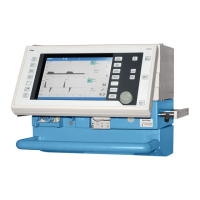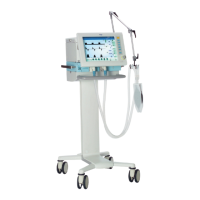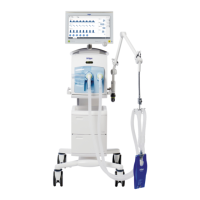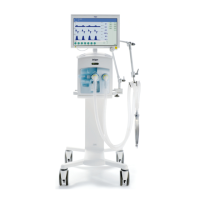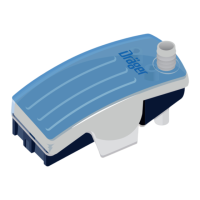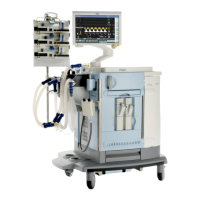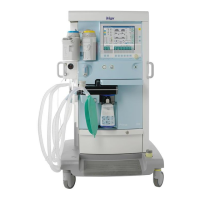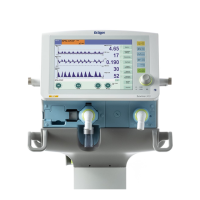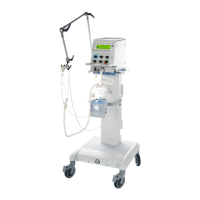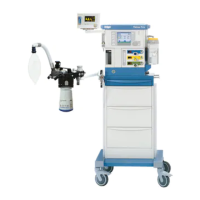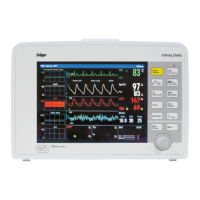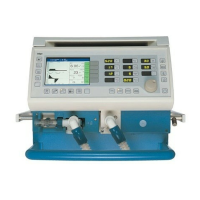
Do you have a question about the Dräger Evita 2 Dura and is the answer not in the manual?
| Weight | approx. 18 kg |
|---|---|
| Power Supply | 100 to 240 V AC, 50/60 Hz |
| Data Connectivity | RS-232 |
| Type | Ventilator |
| Category | Medical Equipment |
| Modes of Ventilation | SIMV, CPAP, Pressure Support |
| Tidal Volume Range | 50 to 2000 mL |
| Respiratory Rate | 2 to 100 breaths/min |
| PEEP | 0 to 20 cmH2O |
| Inspiratory Time | 0.1 to 10 s |
| FiO2 | 21 to 100 % |
| Monitoring Parameters | Pressure, Volume, Flow, FiO2, Respiratory Rate |
| Display | Color TFT |
| Battery Backup | Up to 1 hour |
| Patient Categories | Adult, Pediatric |
| Alarms | Apnea, Disconnection |
Details on the type of humidifier compatible with the software.
New features for apnoea ventilation settings and alarms.
Increased setting range for the apnoea alarm time.
Introduction of BIPAPAssist, 'prev. patient' mode, leakage compensation.
Includes RSB, NIF, and trend parameters for patient assessment.
Features for external flow calculation and remote control pad.
Support for non-invasive ventilation and connection to hospital alarm systems.
Access to simplified settings under 'other modes'.
Emphasizes following instructions, proper maintenance, and using approved accessories.
Warnings against use in explosive areas and safe electrical connections.
Guidelines for safe operation, avoiding flammable substances, and appropriate ventilation monitoring.
Procedure for using a manual device if the ventilator fails.
Description of the ventilator for intensive care use for adults, children, and neonates.
Lists available ventilation modes, special modes, and diagnostic functions.
Details the parameters monitored by the ventilator for therapy assessment.
Describes the keys and rotary knob for setting ventilation parameters and modes.
Identifies keys for menu navigation, screen adjustments, and special functions.
Procedures for turning the device on, off, and placing it in standby mode.
Overview of main and application-specific screen page layouts and their elements.
Details on Settings, Alarms, and Measurements pages for device operation.
Procedures for sensor calibration and system configuration settings.
Explains the meaning of colors used for messages, buttons, and keys.
Instructions for installing the expiration valve, flow sensor, O2 sensor, and optional accessories.
Guidance on the use and potential impact of heat/moisture exchangers and bacterial filters.
Steps for connecting breathing gas humidifiers and ventilation hoses for different patient types.
Procedures for safe transport and sealing device slits if no tray is fitted.
Details on connecting the device to electrical power and gas supplies.
Instructions for connecting the remote control and nurse call system.
Steps for conducting device checks, selecting humidifier type, and performing leakage tests.
Procedures for powering on the device and selecting patient types (Adults, Paediatrics, etc.).
Steps to begin the ventilation process after setup, including checking parameters.
Overview of setting up various ventilation modes like IPPV, SIMV, BIPAP, and their parameters.
How to adjust upper and lower alarm thresholds for various monitored parameters.
Understanding alarm priorities, tones, and visual indicators for warnings and cautions.
How to view graphical waveform data and numerical measured values on the screen.
Includes manual inspiration, expiration hold, medicament nebulisation, and O2 enrichment functions.
Procedures for switching the device to standby and resuming ventilation.
Steps for manually calibrating O2 and flow sensors for accurate measurements.
How to determine and utilize external flow data for monitoring.
Instructions on how to switch specific monitoring functions on or off.
Adjusting audible alarm volume and screen contrast for optimal usability.
Selecting language, date, time, and measurement units for regional adaptation.
Setting up communication interfaces (e.g., printer) and configuring screen display options.
Configuring patient-specific and default ventilation parameters, modes, and alarm limits.
A comprehensive list of error messages, their causes, and solutions for resolving issues.
Procedures for disassembling, cleaning, and disinfecting device parts like sensors, valves, and hoses.
Guidelines for sterilizing components and reassembling the device before patient use.
Schedules for routine maintenance, filter replacement, and proper disposal of parts and the apparatus.
Identifies components and controls on the main unit's front panel.
Locates and names ports and connectors on the front of the device.
Identifies ports, switches, and filters on the rear panel.
Specifies operating/storage conditions and configurable device parameters like ventilation modes.
Details on device performance, measured values, accuracy, and technical limits.
Information on monitoring limits, operating data, machine outputs, and communication protocols.
Lists materials used in device construction and relevant regulatory compliance.
Detailed descriptions of various ventilation modes and their specific operational principles.
Explains flow measurement, compensation techniques, and specific indices like RSB/NIF.
Glossary of technical terms and explanation of graphical symbols used throughout the manual.
Identifies components and order numbers specific to adult ventilation setups.
Identifies components and order numbers specific to paediatric ventilation setups.
Lists order codes for the basic unit, operational accessories, and optional features.
